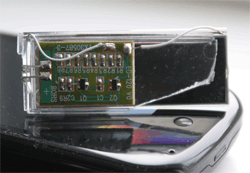Tiny solar powered sensor that supply power forever
Posted By RichC on February 12, 2010
 Gadgets, particularly those with microchips are getting more and more ‘micro’ all the time. For the most part, this leads to improvements in electronic gizmos that serve us daily for convenience and even health. I read an article in TechNewsDaily about a solar-powered sensor that is small enough to supply endless power, yet powerful enough to possibly keep medical implants running indefinitely. One of the new micro-micro sensors being developed at the University of Michigan is said to be 1000 times smaller than comparable chips and can be used with low powered off the shelf low-powered microcontrollers. These can be used to power a variety of electronic monitoring sensors besides the medical devices.
Gadgets, particularly those with microchips are getting more and more ‘micro’ all the time. For the most part, this leads to improvements in electronic gizmos that serve us daily for convenience and even health. I read an article in TechNewsDaily about a solar-powered sensor that is small enough to supply endless power, yet powerful enough to possibly keep medical implants running indefinitely. One of the new micro-micro sensors being developed at the University of Michigan is said to be 1000 times smaller than comparable chips and can be used with low powered off the shelf low-powered microcontrollers. These can be used to power a variety of electronic monitoring sensors besides the medical devices.
 One of the projects I’ve been tinkering with for over 10 years is LCD panels that are switchable in order to curtain or semi-curtain windows for shade or privacy. The low power consumption can make them self contained powered by only a solarcell and capacitor (and possibly battery depending on intended use) and a switch, adjusted manually or automatically depending on time or conditions. Smaller demand for power and lower current needs may make these improve sensors ideal for this project.
One of the projects I’ve been tinkering with for over 10 years is LCD panels that are switchable in order to curtain or semi-curtain windows for shade or privacy. The low power consumption can make them self contained powered by only a solarcell and capacitor (and possibly battery depending on intended use) and a switch, adjusted manually or automatically depending on time or conditions. Smaller demand for power and lower current needs may make these improve sensors ideal for this project.
World’s smallest solar powered sensor runs almost forever
A tiny solar-powered sensor, smaller than Abe Lincoln’s head on a penny, can supply almost perpetual energy, its creators say.
The device contains solar cells, a battery and a processor, all in a package that measures 2.5 by 3.5 by 1 millimeters.
It could enable new biomedical implants as well as new devices to monitor buildings, bridges and homes. “It could vastly improve the efficiency and cost of current environmental sensor networks designed to detect movement or track air and water quality,” the developers said in a statement.
With an off-the-shelf ARM Cortex-M3 processor, the system contains the lowest-powered commercial-class microcontroller. It uses about 2,000 times less power in sleep mode than its most energy-efficient counterpart on the market today.
“Our system can run nearly perpetually if periodically exposed to reasonable lighting conditions, even indoors,” said David Blaauw, an electrical and computer engineering professor. “Its only limiting factor is battery wear-out, but the battery would last many years.”
The new sensor spends most of its time in sleep mode, waking briefly every few minutes to take measurements. Its total average power consumption is less than 1 nanowatt. A nanowatt is one-billionth of a watt.
The developers say the key innovation is their method for managing power. The processor only needs about half of a volt to operate, but its low-voltage, thin-film Cymbet battery puts out close to 4 volts. The voltage, which is essentially the pressure of the electric current, must be reduced for the system to function most efficiently.
“If we used traditional methods, the voltage conversion process would have consumed many times more power than the processor itself uses,” said Dennis Sylvester, an associate professor in electrical and computer engineering.
One way the U-M engineers made the voltage conversion more efficient is by slowing the power management unit’s clock when the processor’s load is light.
“We skip beats if we determine the voltage is sufficiently stable,” Sylvester said.
The system, in the process of being commercialized, could enable less-invasive ways to monitor pressure changes in the eyes, brain, and in tumors in patients with glaucoma, head trauma, or cancer, the scientists say. In the body, the sensor could conceivably harvest energy from movement or heat, rather than light.
This research, presented today at the International Solid-State Circuits Conference in San Francisco, was funded by the National Science Foundation, the Defense Advanced Research Projects Agency, the National Institute of Standards and Technology, the Focus Center Research Program and ARM.
Comments